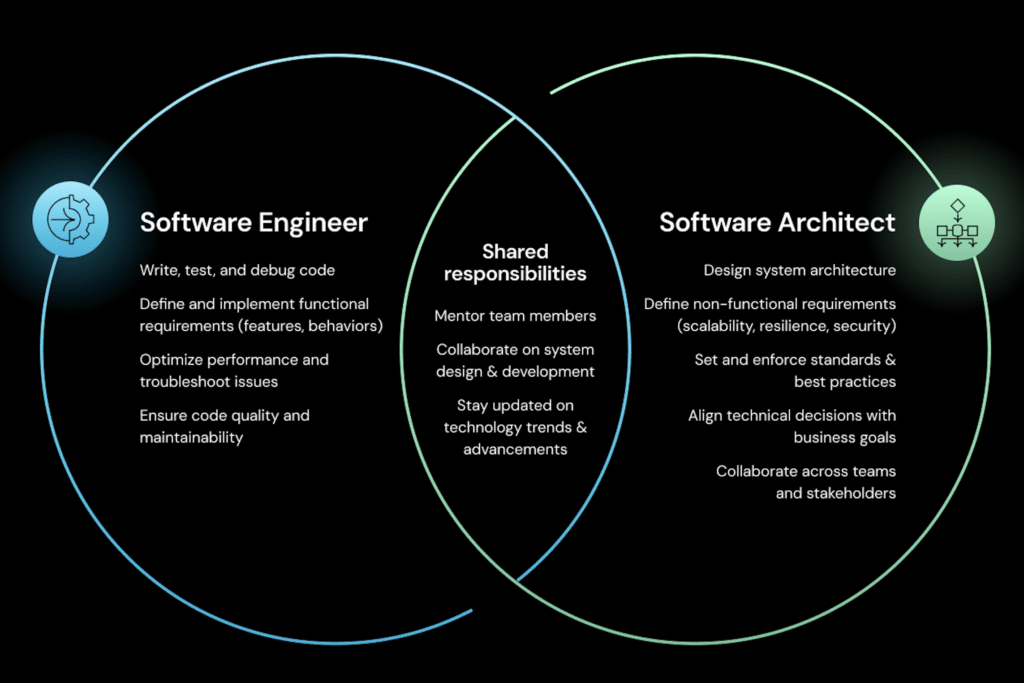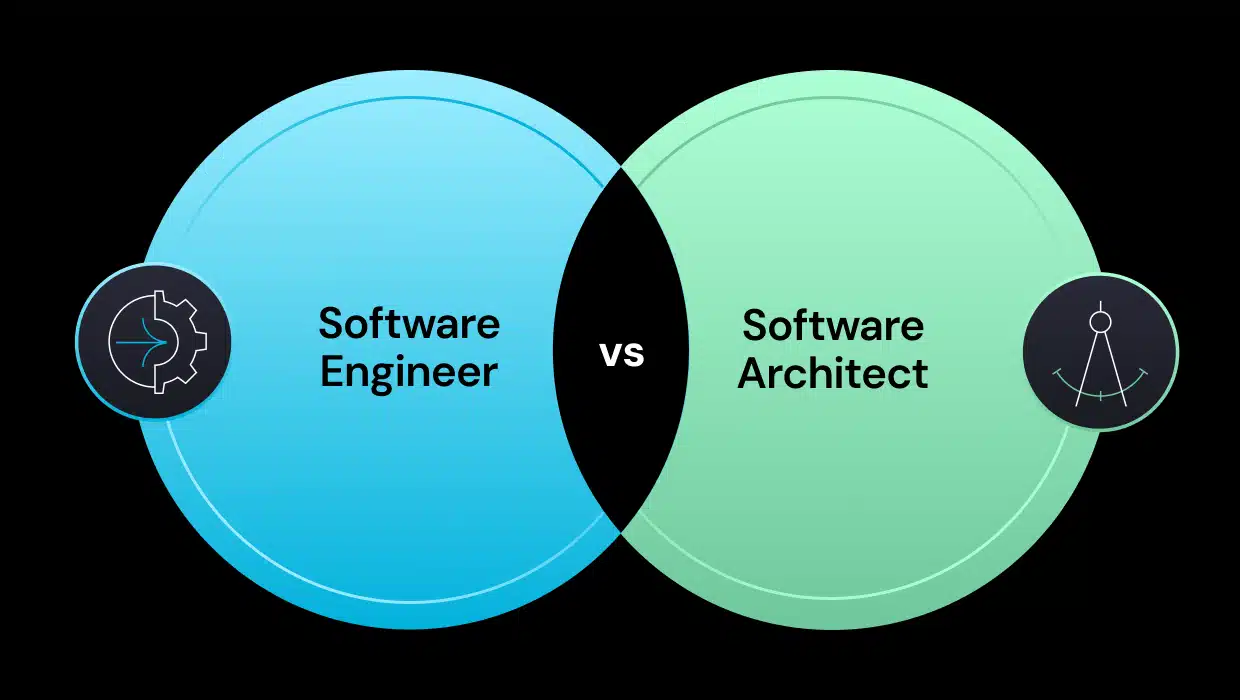Software developers and architects play crucial roles in the software development lifecycle, each bringing unique skills to the table. While their responsibilities may overlap, understanding the key differences (and similarities) between them is essential. This article explores these roles in detail, helping you identify their distinct functions within an organization and in software design and development. Perfect for those choosing a career path, defining roles in a team, or simply seeking to understand these pivotal positions – this article has all that you need to understand these roles well. Let’s dive into what sets them apart and where they converge.
What is a software architect?
Complex software requires design much like buildings or houses require it before construction. During the evolution of the software, any significant modifications to the functionality, technology stack, component structure, or integration of existing software require careful consideration before implementation, just like significant changes to a building may require submitting plans and getting permits. Who looks after these critical functions? Generally, this is the domain of a software architect, sometimes also referred to as an application architect. A software architect is a high-level senior software professional who oversees the overall design of a software system. They are responsible for making strategic decisions that impact the system’s long-term viability, scalability, and performance.

Key responsibilities of a software architect include:
- Design the system architecture: Create the blueprint for the software system, defining its components, and outlining how they interact.
- Technology selection: Choose the right programming languages, development tools, cloud and on-prem services, libraries and frameworks for optimal development and operation of the application.
- Address non-functional requirements (NFRs): Unlike functional requirements, which focus on what the system does, architects look at how the system performs, scales, secures, and operates under different conditions.
- Collaborate with many stakeholders: Work closely with clients, product owners, and development teams to understand requirements and translate them into technical solutions.
- Ensure system quality: Set standards for code quality, performance, and security.
- Make technology decisions: Select appropriate technologies and frameworks to meet project goals.
- Mentor team members: Provide guidance and expertise to junior developers.
To excel as a software architect, you need a solid grasp of software design principles, patterns, and best practices. It’s not just about years in the field but the depth of your knowledge. Even developers or those in non-architect roles who’ve rapidly advanced their skills could be well-suited for this position. Key to thriving in this role are exceptional problem-solving skills, an acute awareness of the broader impacts of design decisions, effective communication, and a comprehensive understanding of various programming languages and technologies.
It’s also important to note that “software architect” is a broad term, encompassing a range of specialized roles depending on the organizational structure. Here’s a breakdown of some common titles that often fall under the umbrella of “software architect.”
| Type of Architect | Role |
| Software architect | Designs the overall structure of software systems, focusing on technical aspects like programming languages, frameworks, and data structures. |
| Application architect | Designs the architecture of specific applications, considering factors like scalability, performance, and security. |
| Enterprise architect | Designs the overall architecture of an organization’s IT systems, aligning technology with business goals. |
| Principal architect | A senior-level architect who provides technical leadership and guidance to development teams. |
| Portfolio architect | Focuses on the alignment of IT investments with business strategy, ensuring that tec |
In many organizations, the exact roles and responsibilities of architects can differ, and the titles they use may vary. However, understanding the different types of architects can help to understand the roles they play in an organization and the skills and expertise required to take on such a role. In the scope of this blog, we will focus on the software or application architect role.
What is a software engineer?
So, if the architect designs the software, who builds it? While some architects can be hands-on and may assist with coding, generally, a team of software engineers or developers is responsible for implementing the software itself. At a high level, a software engineer is a technical expert who implements the software designed by the architect. They are responsible for writing, testing, and debugging code to bring software applications to life.
Key responsibilities of a software engineer include:
- Write code: Develop software applications using various programming languages and frameworks.
- Define functional requirements (FRs): Define the software’s specific features, behaviors, and capabilities, including the system’s expected inputs, outputs, and processes at a detailed level, shaping core functionality vs. NFRs (see above). For example, a software architect may specify that the system must handle up to 1,000 concurrent orders and design the supporting infrastructure, while the engineer defines the tests and implements the solution to meet this requirement.
- Test code: Ensure the quality and functionality of the software through rigorous testing.
- Debug code: Identify and fix errors in the code.
- Collaborate with team members: Work with other developers, designers, and project managers to deliver projects on time.
- Stay updated with technology trends: Continuously learn and adapt to new technologies and methodologies.
It is essential to note that the terms “software engineer” and “developer” are often used interchangeably in the tech industry, but there can be distinctions in their roles, mindset, and how they approach software development. A software engineer typically applies engineering principles to the entire software development life cycle. This means they are involved in not just writing code, but in the planning, design, development, testing, deployment, and maintenance of software systems. A developer is primarily focused on writing code to create software applications. While they do engage in planning and design, especially at the component level, their focus tends to be more on translating requirements into functional software. Think of software engineering as the broader discipline that encompasses the end-to-end process of creating software systems, while development focuses on the day-to-day activities of writing and testing code.
To excel as a software engineer, strong programming capabilities, robust problem-solving skills, and meticulous attention to detail are essential. Familiarity with software development methodologies, including Agile and Scrum, is beneficial, as these frameworks are commonly employed by teams to collaboratively plan and execute software projects.
The path of a software engineer typically progresses from junior to intermediate, and ultimately to senior levels. At the senior tier, some organizations offer advanced titles such as Principal, Staff, or Distinguished Software Engineer. The distinction among these levels primarily lies in the engineer’s accumulated experience and expertise. However, it’s worth noting that in certain organizations, the emphasis is placed more on the engineer’s skill set rather than the duration of their tenure, when determining their level within the company.
Software architect vs. software engineer: Key differences
While both software architects and software engineers are essential to software development, their responsibilities and focus areas differ. Building on our role overview, here’s a detailed comparison. While responsibilities vary by organization, they can generally be grouped into these categories:
| Feature | Software Architect | Software Engineer |
| Primary role | Designs the overall software systems | Implements software designs and writes code |
| Focus | High-level design principles, system architecture, NFRs, and strategic planning | Low-level implementation details, coding standards, FRs, and debugging |
| Scope | The entire software system, including its components, interactions, dependencies | Specific modules or features within the system |
| Time horizon | Long-term, strategic thinking, often involved in the initial stages of a project | Short-term, tactical execution, focused on delivering specific tasks and features |
| Communication | Frequent interaction with stakeholders, including clients, product owners, and project managers | Primarily with team members, including other developers, testers, and designers |
| Technical depth | Broad knowledge of various technologies, frameworks, and industry trends | Deep expertise in specific programming languages, tools, and methodologies |
| Problem solving | Focuses on solving complex, high-level design problems | Focuses on solving specific coding and implementation challenges |
The blurred line: When software architect and software engineer roles overlap
Working in a position that seems to morph the two roles together? You’re not alone. Many architects and engineers find themselves in this situation. In many organizations senior engineers act as pseudo-architects, making key design and planning decisions.
Renowned architect, speaker and author of “The Software Architect Elevator”, Gregor Hohpe, captured this reality at a conference, “My view on this is really, it’s not anything on your business card. I’ve met great architects whose title is an architect. I met people who have the word on the business card where I would say, in my view, they’re not such great architects. It happens. It’s really a way of thinking, a lifestyle almost.”
In organizations that don’t have an official architect role, someone still needs to do the work of an architect, and that person is usually a senior developer or tech lead on the team. This is pretty common, especially with smaller startups or tech businesses with smaller development teams. However, larger, more established organizations that deal with large, complex software systems and strict compliance requirements, such as financial services and banking, healthcare and life sciences, and automation and manufacturing, tend to have a more formal architect/engineer separation of roles.
Understanding the differences and overlap between these two roles clarifies their functions and responsibilities within the SDLC. This insight helps in deciding which role and skillset are necessary for completing tasks or enhancing capabilities within your organization.
When to choose a software architect?
Have a large or complex project you’re taking on and need to have in-depth analysis and design done? Looking to do an on-prem to cloud migration? A large digital transformation initiative? These jobs are good opportunities to leverage the skills of a software architect.
A software architect is typically a great fit when a project requires:
- Complex system design: When the system involves multiple interconnected components and intricate workflows, a software architect can design a robust and scalable architecture.
- Long-term planning: For projects with a long lifespan, a software architect can ensure the system can evolve and adapt to future needs.
- Performance optimization: When performance is critical, a software architect can identify bottlenecks and optimize the system’s design.
- Technical leadership: To guide the development team and make strategic decisions about technology choices and best practices as well as translate architectural decisions into business value, bridging gaps between stakeholders.
- Risk mitigation: By anticipating potential challenges and designing for resilience, a software architect can help minimize risks.
In essence, a software architect is essential when a project requires a solid foundation, strategic thinking, and technical leadership. It’s not to say that an experienced software engineer couldn’t take on these tasks, but software architects specialize in the nuances of strategic planning and looking to the future and how current decisions will affect the future state of the software.
When to choose a software engineer?
If you’re implementing software, you’ll need a software engineer on your team. The engineer is the critical piece that takes the designs and planning of the architect and turns it into a tangible and working piece of software. Although an architect can likely code, many software engineers specialize in the languages and technologies that have been selected to build the project. A software project can likely still come to fruition without an architect since developers may possess the essentials to push through designing a system (even if less efficient than an architect may do it); however, without software engineers, it would be almost impossible to see the systems come to life.
A software engineer is critical when a project requires:
- Implementing code: To translate designs into functional code.
- Debugging and testing code: To identify and fix issues in the code and ensure its quality.
- Maintenance and support: To maintain existing systems and provide ongoing support.
- Rapid development: To quickly deliver features and functionality.
- Specific technical skills: For tasks that require expertise in particular programming languages, frameworks, or tools.
In essence, a software engineer is essential for the hands-on implementation and maintenance of software systems. Without the work of the engineer, most software projects would simply dissipate after the design stage.
The software development industry is currently at risk of minimizing the need for human developers and software engineers due to advancements in AI. AI coding assistants are streamlining workflows by automating routine tasks, suggesting code enhancements, and identifying potential bugs, which boosts efficiency but also leads to smaller engineering teams. Encouraged by these capabilities, Meta announced a plan to replace mid-level engineers with AI to cut costs and optimize processes.
However, this shift brings risks. AI lacks the human capacity for intuitive problem-solving and creative thinking, crucial for addressing complex, unstructured challenges often encountered in development. Over-reliance on AI may stifle innovation and undermine team dynamics critical for collaborative environments. Security vulnerabilities and ethical concerns may also be overlooked without the nuanced judgment and oversight provided by human engineers. While AI speeds up code generation, it doesn’t inherently ensure that the generated code aligns with the system’s architecture, dependencies, or long-term maintainability — introducing potential integration challenges, performance issues, and technical debt. Hence, while AI can significantly aid development, it cannot wholly replace the unique contributions of human intelligence in software engineering.
Software architect vs. software engineer: Which is better?
Deciding between a software architect and an engineer depends on the task at hand and the individual’s skills. While architects often handle design and strategy, engineers focus on building the software. The “best” role is determined by the specific needs of the project, which may sometimes require skills from both roles.
In a scenario where an organization has both roles available, the ideal scenario often involves a collaborative effort between the two of them. While a software architect provides the strategic vision, a software engineer brings it to life through implementation. As mentioned previously, in many organizations, these roles may overlap, with individuals taking on responsibilities of both.
However, not all organizations have dedicated software architects. In smaller teams or startups, developers may take on architectural responsibilities, making design decisions and planning the system’s structure. Even in larger organizations, there may be situations where a senior developer or team lead assumes the role of a de facto architect.
When it comes to determining which role you actually require for your project, you’ll need to take into account a few different factors, including:
- Project complexity: For complex software systems, a dedicated Software Architect can provide valuable guidance and oversight.
- Team size and experience: Smaller teams may not require a dedicated architect, while larger teams may benefit from the expertise of a specialized role.
- Organizational structure: The organizational culture and processes can influence the need for a dedicated architect.
- Budget constraints: Hiring a dedicated software architect may not be feasible for all organizations since the wages tend to be higher than that of a traditional software engineer.
When it comes to determining which role you actually require for your project, you’ll need to take into account a few different factors, including:
- Project complexity: For complex software systems, a dedicated Software Architect can provide valuable guidance and oversight.
- Team size and experience: Smaller teams may not require a dedicated architect, while larger teams may benefit from the expertise of a specialized role.
- Organizational structure: The organizational culture and processes can influence the need for a dedicated architect.
- Budget constraints: Hiring a dedicated software architect may not be feasible for all organizations since the wages tend to be higher than that of a traditional software engineer.
Career growth and salary comparison
Typically, a successful software architect has a strong foundation in software engineering and often has several years of experience in software development. A solid understanding of software design principles, system architecture, and problem-solving skills is essential. As a software engineer’s career matures and their skills grow, many software engineers transition into software architect roles. With experience, this becomes easier to do since it gives time to demonstrate leadership qualities, build the skills for strategic thinking, and a deep understanding of the software development process.
Software engineers typically have a strong foundation in computer science or a related field. They possess strong programming skills, problem-solving abilities, and a passion for technology. While many software engineers continue to specialize in specific technologies or domains, others may aspire to leadership roles, including development team/technical team lead or within the architecture domain.
At a high level, here’s how the roles and career paths break down:
| Role | Career paths |
| Software architect | Technical leadership, management, consulting |
| Software engineer | Technical specialization, team leadership, senior engineerin |
Salary comparison
Another very important factor in this decision is the salary that comes with the role. Generally, architects are seen as a more senior role; however, senior developer roles such as those at the staff or principal software engineer level are just as coveted. Below is a high-level breakdown of average wages in the US for both roles. Being near a tech hub like San Francisco, or working for a FAANG company like Amazon typically commands higher salaries compared to less urban areas or smaller companies. Here’s how it all breaks down:
| Role | Low range (USD) | Average range (USD) | High range (USD) |
| Software architect | $140,000 | $174,000 | $200,000 |
| Software engineer | $120,000 | $150,000 | $170,000 |
Reference Zip Recruiter
Equity and stock options can also play a large role in overall compensation. At some organizations, salary is only a small component of the potential upside of taking a role. Emerging markets, such as cloud and AI, can also demand extremely high salaries well beyond the average mentioned here. For example, the median total compensation (base salary, equity, and other benefits) for engineers at OpenAI is reported to be around $900,000 annually. The architects working there seem to make less. This discrepancy likely stems from the fact that AI engineers are directly involved in cutting-edge model development and research, which is a highly specialized and in-demand skill set. Architects, on the other hand, typically focus on system design and integration, which, while crucial, may not attract the same compensation premiums in the AI space. This is just one example of why you should take the importance and salary that comes with a role with a grain of salt.
Conclusion
In conclusion, both software architects and software engineers play crucial roles in the software development process. While architects focus on the high-level design and strategic planning of systems, engineers are responsible for the implementation and maintenance of code.
By understanding the key differences between these roles and the specific needs of your project and organization, you can make informed decisions about the composition of your development team. A balanced approach, combining the strategic vision of architects with the technical expertise of engineers, is essential for successful software development.
vFunction empowers architects and engineers by providing deep architectural insights, visualizing complex dependencies, and enabling continuous governance. Architects can proactively identify design flaws and enforce best practices, while engineers gain the clarity needed to build and refactor efficiently. By bridging the gap between high-level strategy and hands-on implementation, vFunction helps teams create resilient and scalable software that evolves with business needs—without the growing pains of unchecked complexity.







